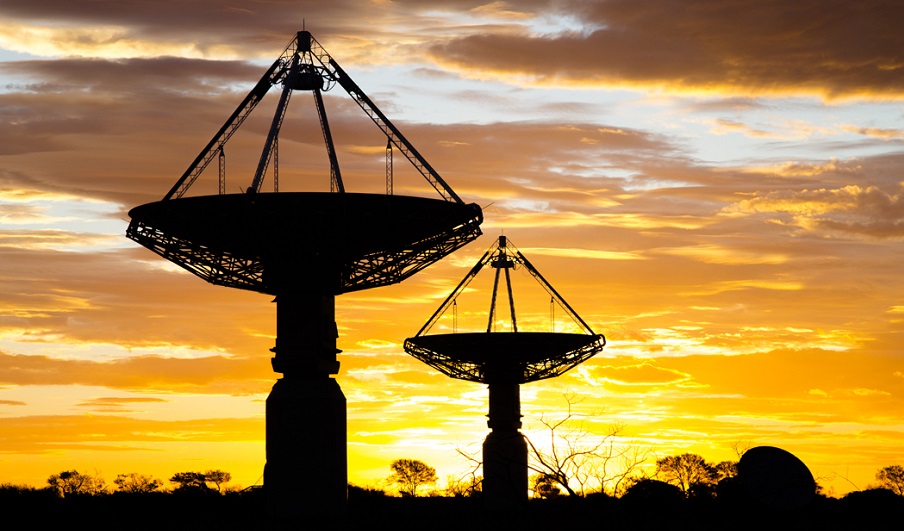Message from Aliens? New Australian telescope finds Mystery Alien Signal days after being turned on
Have we really received a message from an alien race from elsewhere in the cosmos? A new Australian telescope—which was turned on a couple of days ago, has intercepted a new Fast Radio Burst, leaving experts baffled. The FRB’s brightness and distances mean that the energy involved in the process was ENOUIRMOUS, which makes it extremely difficult to explain.
Just four days after scientists turned on the Australian square Kilometer Array Pathfinder Telescope, aka ASKAP (Phew), it intercepted a set of RARE and MYSTERIOUS radio waves known as Fast Radio Busts, originating in the constellation Leo.
The enigmatic radio signals, which last just a few milliseconds, are believed to originate billions of light years away from Earth, in distant parts of our universe, but experts have absolutely no idea what is causing them.
One theory—of course—is ALIENS.
Using just eight of the telescope’s dishes, scientists from the Commonwealth Scientific and Industrial Research Organization (CSIRO), Curtin University, and the International Centre for Radio Astronomy Research (ICRAR) managed to pick up the new FRB.
The telescope—which consists of 36 identical parabolic antennas, each 12 meters in diameter, working together as a single instrument with a total collecting area of approximately 4,000 square meters—can see 240 square degrees at once, utilizing only eight of its antennas.
The new Fast Radio Burst was dubbed by experts as FRB170107 and was extremely bright, researchers have said, which made it extremely easy to spot.
Scientists are convinced that by using the additional antennas of the Australian square Kilometer Array Pathfinder Telescope, they’ll be able to uncover other Fast Radio Bursts as well.
“We can expect to find one every two days when we use 12 dishes, our standard number at present,” Dr. Keith Bannister said.
According to experts, the newly found FRB originate from the edge of the constellation Leo and seems to have traveled through outer space for SIX billion years before slamming into the ASKAP at the speed of light.
But that’s precisely what makes the FRB so mysterious. The FRB’s brightness and distances mean that the energy involved in the process was ENOUIRMOUS, which makes it extremely difficult to explain.
“We’ve made a hard problem even harder,” said Dr. Ryan Shannon (CSIRO, Curtin University, and ICRAR), who analyzed the burst’s strength and position. CSIRO Chief Executive Dr. Larry Marshall said the FRB detection was a sign of the full potential of ASKAP.
“Radio astronomy has a long history of innovation in high-speed communications, and this unique capability is embedded into ASKAP – from the receiver to the signal processing – making it a uniquely powerful instrument for astronomy,” Dr. Marshall said.
So what are these mysterious signals?
One option is ALIENS
A new study has claimed that the mysterious signals, which originate from distant galaxies could be evidence of deep-space explorers located billions of light-years from Earth.
A new study has claimed that the mysterious signals, which originate from distant galaxies could be evidence of deep-space explorers located billions of light-years from Earth.
Experts from the Harvard-Smithsonian Center for Astrophysics believe that solar-powered transmitters, using sunlight cast on an area TWICE the site of our planet could generate energy which is detectable by far away viewers—like us on Earth.
“Fast radio bursts are exceedingly bright given their short duration and origin at great distances, and we haven’t identified a possible natural source with any confidence,” said theorist Avi Loeb of the Harvard-Smithsonian Center for Astrophysics. “An artificial origin is worth contemplating and checking.”
Furthermore, they add that a SUPER water-cooling system would help allow a DEVICE of such size withstand extreme heat and function normally.
But why build such an instrument in the first place wondered experts? They argue that the most plausible use of such power is driving interstellar light sails. The amount of power involved would be sufficient to push a payload of a million tons, or about 20 times the largest cruise ships on Earth.


Comments
Post a Comment